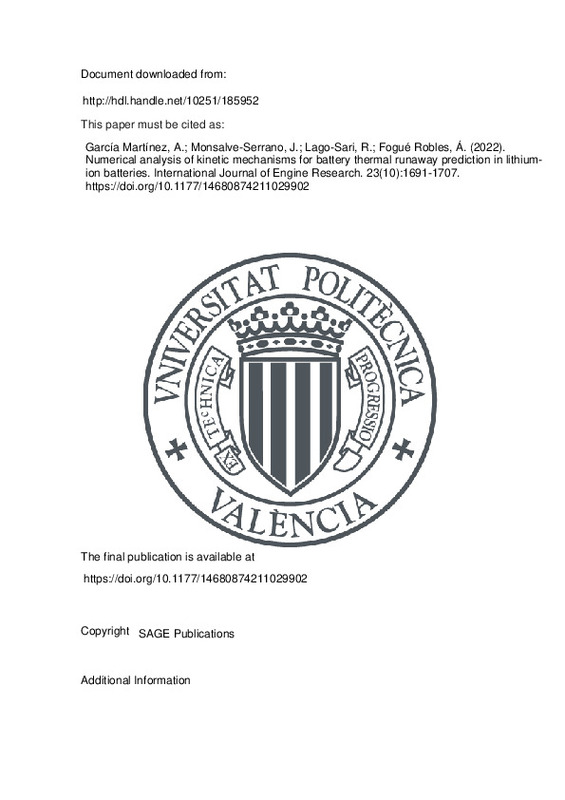JavaScript is disabled for your browser. Some features of this site may not work without it.
Buscar en RiuNet
Listar
Mi cuenta
Estadísticas
Ayuda RiuNet
Admin. UPV
Numerical analysis of kinetic mechanisms for battery thermal runaway prediction in lithium-ion batteries
Mostrar el registro sencillo del ítem
Ficheros en el ítem
| dc.contributor.author | García Martínez, Antonio
|
es_ES |
| dc.contributor.author | Monsalve-Serrano, Javier
|
es_ES |
| dc.contributor.author | Lago-Sari, Rafael
|
es_ES |
| dc.contributor.author | Fogué Robles, Álvaro
|
es_ES |
| dc.date.accessioned | 2022-09-13T18:02:44Z | |
| dc.date.available | 2022-09-13T18:02:44Z | |
| dc.date.issued | 2022-10 | es_ES |
| dc.identifier.issn | 1468-0874 | es_ES |
| dc.identifier.uri | http://hdl.handle.net/10251/185952 | |
| dc.description.abstract | [EN] The urgent need for reducing the carbon dioxide emissions has led to the powertrain electrification at different levels such as hybridization or pure electric vehicles. Despite the benefits in terms of local pollution reduction and lower carbon dioxide footprint that may be achieved with this technology, new hazards have been introduced. Among them, the combustion of the battery pack due to abuse conditions, also known as thermal runaway, is one of the biggest concerns. It can lead to the vehicle combustion under unnoticed failure conditions, threating the driver security. In this sense, different investigations have been carried out with the aim of providing a proper description of the reactions that lead to this phenomenon. Reaction mechanisms have been proposed in the literature for lithium-ion battery considering the most common battery chemistries. Nonetheless, their application leads to different results, which may hinder their utilization in modeling critical operating conditions for thermal runaway. This investigation proposes a detailed assessment of the most common reaction mechanisms, comparing their capability on reproducing the different reaction paths that lead to thermal runaway conditions to explore and depict state of the art of thermal runaway modeling. Additionally, a detailed analysis is performed to define the differences in terms of decomposition and formation reactions for each one of them. The results of this investigation demonstrate that the mechanism proposed by Kriston provides the best results trade-off considering different investigations in differential scanning calorimeter and accelerated rate calorimeter. In addition, it was found that some mechanisms have been adjusted to perform similar to the experimental results, even in the case of not having a physical meaning. | es_ES |
| dc.language | Inglés | es_ES |
| dc.publisher | SAGE Publications | es_ES |
| dc.relation.ispartof | International Journal of Engine Research | es_ES |
| dc.rights | Reserva de todos los derechos | es_ES |
| dc.subject | Battery thermal runaway | es_ES |
| dc.subject | Vehicle safety | es_ES |
| dc.subject | Kinetic mechanism | es_ES |
| dc.subject | Electric vehicles | es_ES |
| dc.subject.classification | MAQUINAS Y MOTORES TERMICOS | es_ES |
| dc.title | Numerical analysis of kinetic mechanisms for battery thermal runaway prediction in lithium-ion batteries | es_ES |
| dc.type | Artículo | es_ES |
| dc.identifier.doi | 10.1177/14680874211029902 | es_ES |
| dc.rights.accessRights | Abierto | es_ES |
| dc.contributor.affiliation | Universitat Politècnica de València. Departamento de Máquinas y Motores Térmicos - Departament de Màquines i Motors Tèrmics | es_ES |
| dc.description.bibliographicCitation | García Martínez, A.; Monsalve-Serrano, J.; Lago-Sari, R.; Fogué Robles, Á. (2022). Numerical analysis of kinetic mechanisms for battery thermal runaway prediction in lithium-ion batteries. International Journal of Engine Research. 23(10):1691-1707. https://doi.org/10.1177/14680874211029902 | es_ES |
| dc.description.accrualMethod | S | es_ES |
| dc.relation.publisherversion | https://doi.org/10.1177/14680874211029902 | es_ES |
| dc.description.upvformatpinicio | 1691 | es_ES |
| dc.description.upvformatpfin | 1707 | es_ES |
| dc.type.version | info:eu-repo/semantics/publishedVersion | es_ES |
| dc.description.volume | 23 | es_ES |
| dc.description.issue | 10 | es_ES |
| dc.relation.pasarela | S\461512 | es_ES |







![[Cerrado]](/themes/UPV/images/candado.png)

